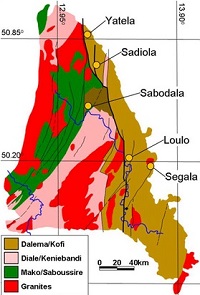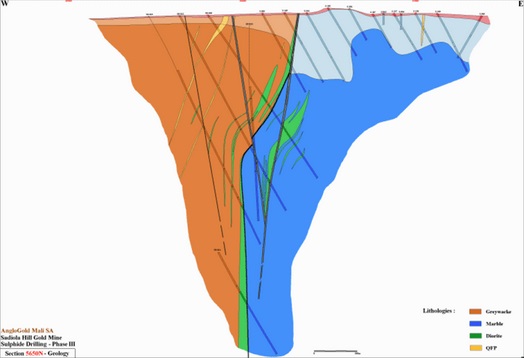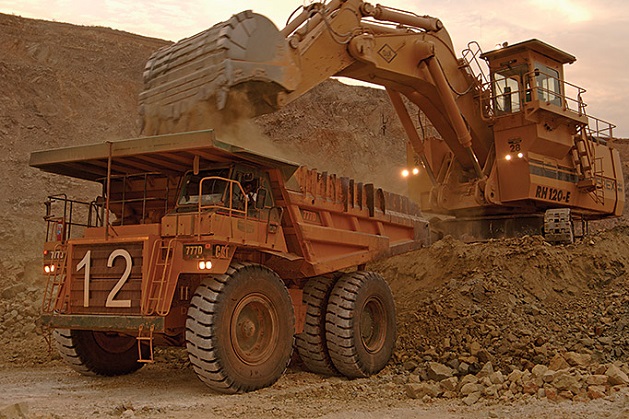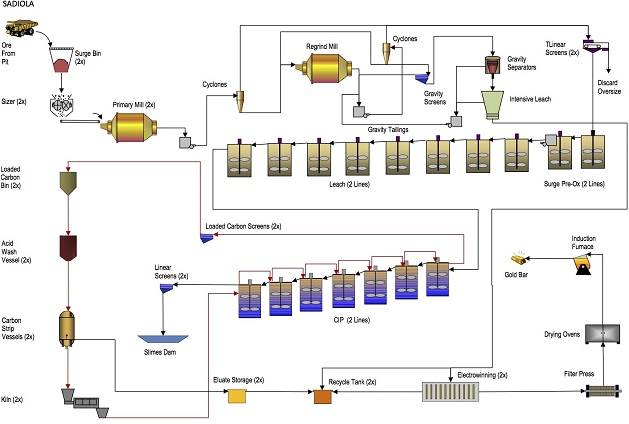 Location
Location

The Sadiola Gold Mine is located in southwest Mali, West Africa near the Senegal Mali border, approximately 70 kilometres south of the town of Kayes, the regional capital. Kayes has a population of roughly 100,000 people and is located 510 kilometres northwest of the Mali capital Bamako.
The Republic of Mali is a landlocked nation bordering Algeria on the north, Niger on the east, Burkina Faso and the Côte d'Ivoire on the south, Guinea on the southwest and Senegal and Mauritania on the west. The country is just over 1,240,000 km² with an estimated population of almost 12,000,000.
The Sadiola mining permit covers an area of 302 km² in a remote part of Mali with little infrastructure. The minesite is accessed by a regional gravel road to Kayes. There is an airstrip at the Sadiola Gold Mine capable of handling light chartered aircraft. Kayes is serviced by rail, road and air from Bamako and from Dakar, the capital of Senegal. Bamako has an international airport with daily flights to many West African and European destinations. Dakar is a major port of entry to West Africa by sea and air and the primary supply route for imported goods coming to the minesite.
History
The Sadiola deposit was initially identified as a favourable gold exploration area based upon the widespread evidence of artisanal gold workings and small scale mining by locals.
From 1987 to 1989, a large regional geochemical survey was carried out for the government of Mali as part of an aid program financed by the European Development Fund. The survey identified high gold, arsenic and antimony anomalies near the villages of Sadiola and Dinguilou. In 1990 the government of Mali granted exploration rights in respect of the Sadiola area to an entity associated with the initial formation of IAMGOLD. Subsequent geological mapping, geophysical surveys, pitting and core drilling identified a significant oxide gold deposit.
During 1991 and 1992 IAMGOLD retained Watts, Griffis and McOuat (“WGM”), prepared a preliminary economic assessment of the Sadiola prospect, and recommended a large exploration program with emphasis on drilling to delineate and confirm the mineral resource at Sadiola. In December 1992 WGM estimated a probable reserve of 22.3 million tonnes of oxide mineralization grading 3.3 g/t gold. Later in 1992, IAMGOLD negotiated a JV agreement with AngloAmerican for the development of the Sadiola mine. The gold assets of AngloAmerican were eventually spun off to form the largest part of a new company: AngloGold Ashanti who are currently the operator of the Sadiola Gold Mine.
Milestones
1987 Government of Mali began exploration of Sadiola area
1990 IAMGOLD obtained rights and explored Sadiola Hill and surrounding areas
1992 IAMGOLD and AngloGold Ashanti (then AngloAmerican), joint venture to build the mine site
1994 Joint Venture granted Sadiola Mining Permit (IAMGOLD (38%), AngloGold Ashanti (38%
1994 and operator), Government of Mali (18%) and International Finance Corporation (IFC – a World Bank
1994 entity) 6%)
1996 December 20th Sadiola poured its first gold bar
2009 IAMGOLD and AngloGold Ashanti both acquire an additional 3% share each in the joint venture.
2009 The parties' shares are now IAMGOLD 41%, AngloGold Ashanti 41%, Government of Mali 18%.
Geology

The Sadiola deposit is located within the Malian portion of the Kenieba–Kedougou window, a major Palaeoproterozoic inlier along the northeast margin of the Kenema–Man shield. The Birimian components of the window can be interpreted as a collage of at least two N-S trending terranes. To the west, an older (+/- 2.2 Ga) volcano-sedimentary succession intruded by major calc-alkaline batholiths belongs to the Saboussire Formation. It is separated from the dominantly sedimentary Kofi Formation by the major north to northeast trending Senegalo-Malian Shear Zone. The Kofi Formation is significantly younger and intruded by calc-alkaline batholiths dated at 2.0 – 2.05 Ga. Metamorphic grade attains greenschist facies, with amphibolite grades developed locally near major intrusions. The Senegalo-Malian Shear Zone hosts several significant gold deposits along its splays including Sadiola, Yatela, Loulo and Yalea.
The Sadiola deposit is located in the north central section of the window and is hosted by sediments of the Kofi Formation, which have been intruded by numerous felsic intrusives. The sediments consist of fine-grained greywacke, probably distal turbidites, and impure carbonates with minor tuffs and acid volcanics.
The deposit occurs along the 010º striking Sadiola Fracture Zone (“SFZ”), which is interpreted as a brittle-ductile splay off the Senegalo-Mali Shear Zone at a sinistral releasing bend. The SFZ follows the steeply west dipping contact between greywacke to the west and impure carbonate to the east. The SFZ and its wallrock are intruded by discontinuous diorite dykes, which may contain a weak mineral foliation and rarely intense ductile deformation. Quartz-feldspar-porphyry (QFP) dykes intrude younger, 020º striking and steeply west dipping faults and preserve more brittle deformational features.
Mineralization

Pervasive gold mineralisation ranging in grade from 2 g/t to 20 g/t occurs along the SFZ over a strike length of approximately 2,500 metres and remains open to the north and south. The location and geometry of high grade mineralisation appears to be controlled by the confluence of the SFZ with the 020º striking splays, resulting in steeply to vertically plunging zones within the plan of the SFZ.
Gold mineralisation occurs in all of the four major rock types (marble, greywacke, diorite and quartz-feldspar porphyry), and is spatially associated with a complex alteration pattern. Alteration assemblages identified to date include calcsilicate, potassic, chlorite–calcite and carbonate and point to a mesothermal origin for gold mineralisation. Gold is associated with both arsenic and antimony dominated sulphide assemblages including arsenopyrite, pyrrhotite, pyrite, stibnite and gudmundite. Primary gold is extremely fine grained, dominantly less than 15 microns, with rare grains approaching 50 microns.
The Sadiola deposit has been intensely weathered to depths of up to 220 metres. The operation has mainly exploited soft oxide ore since startup with the current known oxide reserves expected to be mined out by 2016. A significant mineral resource of hard sulphide ore occurs below the final Sadiola pit design and is currently the target of an expansion project pending final approvals.
Mining

The Sadiola Gold Mine is operated by AngloGold Ashanti.
Mining is carried out using conventional open pit techniques with a carbon-in-pulp processing plant. There are currently five open pits. The main pit oxide resource recently completed mining however mining is currently occurring in the satellite orebodies FE3 and FE4 southeast of the main pit.
The pit slopes have been engineered to industry standards of stability for the range of lithologies present at Sadiola, following risk management principles. Grade control is effected by drilling 10 metre long vertical holes on a 10 metre by 5 metre grid. Ore is transported to the ore stockpile located one kilometre from the pit and waste is disposed of in dumps adjacent to the pit.
Approximately 90% of ore is stockpiled before processing. The ore stockpiling facility is located between the pit and the process plant and its purpose is twofold. Primarily, the area allows stockpiles of ore with differing oxide and sulphide mineralogy, gold grades, hardness, viscosity levels to be laid down separately. Ore is reclaimed from the stockpiles and fed into the process plant on a blended basis contributing to the efficiency of the process plant and maximising gold recovery. The second function of the stockpile is to provide a reserve of ore to sustain feed when pit operations are affected by external

The Sadiola Gold Mine processing plant consists of two identical parallel circuits, collectively capable of treating approximately 5.3 million tonnes of saprolite ores per year. This twin-stream design allows for a degree of flexibility in plant operation and maintance in the event of equipment failure, important in this case as local infrastructure and maintenance support for heavy industry is virtually non existent.
Most of the ore is delivered from the pit to a stockpile/reclaim area, adjacent to the processing plant site. The ore blend is reclaimed from the stockpile and fed to two parallel mineral sizers, a type of crusher designed to handle the softer ores that are found at the Sadiola Gold Mine. The ore passes to surge bins located ahead of the two SAG mills. A single regrind mill is incorporated, serving both circuits, to further grind the coarse fraction contained in the output from the SAG mills.
The discharge from the mills is fed to cyclones, the overflow from which goes to the leach circuit where the pulp is subject to cyanide leaching while the underflow goes to the regrind mills. Following leaching, the pulp is fed to CIP adsorption tanks where the gold is absorbed onto activated carbon. This ‘‘loaded’’ carbon is stripped of its gold and the gold bearing solution is pumped to storage tanks. The stripped carbon is regenerated in an oil fired kiln and then reused. After leaching, the barren slurry after removal of the gold is pumped to the tailings dam 3 kilometres southeast of the process plant for final disposal. The gold is recovered from the solution by electroplating onto stainless steel wool cathodes. The cathodes are washed and the gold bearing sludge dried and placed in an induction furnace for smelting to produce gold bullion.
In 2002, the Sadiola plant was modified to increase the recovery on the sulphidic saprolite ore from approximately 65% to 75%. In 2008 a gravity circuit was commissioned to treat a portion of the cyclone underflow in the grinding circuit. The circuit has allowed for improved recovery on high grade oxide ores from the satellite pits that contain a significant coarser “nuggety” gold fraction.


 The Sadiola deposit is located within the Malian portion of the Kenieba–Kedougou window, a major Palaeoproterozoic inlier along the northeast margin of the Kenema–Man shield. The Birimian components of the window can be interpreted as a collage of at least two N-S trending terranes. To the west, an older (+/- 2.2 Ga) volcano-sedimentary succession intruded by major calc-alkaline batholiths belongs to the Saboussire Formation. It is separated from the dominantly sedimentary Kofi Formation by the major north to northeast trending Senegalo-Malian Shear Zone. The Kofi Formation is significantly younger and intruded by calc-alkaline batholiths dated at 2.0 – 2.05 Ga. Metamorphic grade attains greenschist facies, with amphibolite grades developed locally near major intrusions. The Senegalo-Malian Shear Zone hosts several significant gold deposits along its splays including Sadiola, Yatela, Loulo and Yalea.
The Sadiola deposit is located within the Malian portion of the Kenieba–Kedougou window, a major Palaeoproterozoic inlier along the northeast margin of the Kenema–Man shield. The Birimian components of the window can be interpreted as a collage of at least two N-S trending terranes. To the west, an older (+/- 2.2 Ga) volcano-sedimentary succession intruded by major calc-alkaline batholiths belongs to the Saboussire Formation. It is separated from the dominantly sedimentary Kofi Formation by the major north to northeast trending Senegalo-Malian Shear Zone. The Kofi Formation is significantly younger and intruded by calc-alkaline batholiths dated at 2.0 – 2.05 Ga. Metamorphic grade attains greenschist facies, with amphibolite grades developed locally near major intrusions. The Senegalo-Malian Shear Zone hosts several significant gold deposits along its splays including Sadiola, Yatela, Loulo and Yalea.


